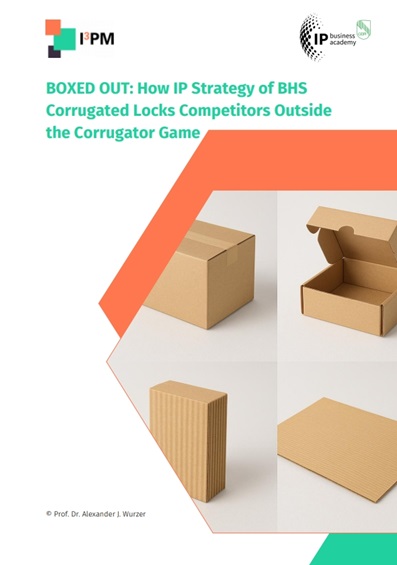Why you shouldn’t glance past a cardboard box
Most people never pause to consider the corrugated board keeping their online impulse‑buys safe. They should. Behind roughly every third box you touch stands BHS Corrugated – an engineering icon founded in 1717 that has reinvented itself more times than packaging trends have changed. The new case study dissects how the German company turned intellectual property (IP) into a competitive fortress and why that matters far beyond box plants. Read on if you like your strategy with a twist of boldness and a dash of industrial romance.
Then read the full case, because the devil, and the delight, is in the details.
Why It Matters Beyond Cardboard
E-commerce continues its relentless expansion, while EU sustainability regulations like the Packaging and Packaging Waste Regulation (PPWR) have made recyclable packaging not just preferable but absolutely non-negotiable for market participation. Within this rapidly evolving landscape, BHS demonstrates how an established industrial player can strategically weaponize intellectual property to maintain competitive advantage across multiple dimensions.
The company’s approach focuses on preserving pricing power precisely when hardware components risk becoming commoditized. Rather than competing solely on manufacturing efficiency or material costs, BHS uses its IP portfolio to maintain premium positioning even as competitors flood the market with similar physical products. This strategy proves particularly crucial when traditional manufacturing advantages erode and differentiation becomes increasingly difficult to maintain through hardware alone.
Equally important is how BHS anchors the margins of its digital services, recognizing that Wall Street consistently assigns higher valuations to service-based revenue streams than to steel and manufacturing operations. By protecting the intellectual property that underpins these digital offerings, the company ensures that its most valuable revenue components remain defensible against competitive pressure and market commoditization.
Perhaps most strategically, this IP approach buys the company something invaluable: time. Time for research and development teams to develop next-generation solutions, time for organizational culture to adapt to new market realities, and time to execute the next strategic pivot when market conditions demand it. This temporal advantage exists because blocking competitor revenue streams proves far more effective than merely blocking the replication of individual components or bolts.
The Great IP Awakening
Until 2021, patents at BHS Corrugated were treated like housekeeping, necessary but hardly strategic. Then reality bit: low‑cost imitators nibbled at BHS’s 50 % global share, and uptime‑based service contracts magnified every infringement risk. Cue a mindset overhaul anchored in one deceptively simple line: “IP as strategic asset safeguarding customer value.”
What followed is worth framing:
- Business‑model blocking, not feature fencing. Claims are drafted to stop competitors from copying the revenue logic, not just the gadget.
- Synthetic invention. If an idea protects revenue, they file overlapping patents around every conceivable variant—“synthetisches Erfinden”.
- DIN 77006 governance. A lean, three‑person IP team operates as an internal law firm while business units pay the bills, turning abstract IP cost into P&L reality.
Result: patents as forward artillery, not rear‑guard paperwork.
Your Move
For those crafting IP strategies or advising others in this process, BHS Corrugated’s approach raises fundamental questions that deserve serious consideration. The first involves examining whether current efforts focus on protecting individual inventions or the broader value flows that drive business success. This distinction often separates truly strategic IP portfolios from merely defensive collections of patents and trademarks.
The second question challenges conventional thinking about portfolio scope and impact. Rather than asking whether patents protect specific innovations, the more relevant inquiry becomes whether the entire portfolio could effectively halt a competitor’s business model entirely. This shift from component-level to system-level thinking often reveals significant gaps in traditional IP strategies.
Finally, organizations must honestly assess whether their key  performance indicators make intellectual property everyone’s responsibility, ideally transforming it from a legal department burden into an exciting company-wide opportunity. When IP creation and protection become embedded in organizational culture rather than relegated to specialist functions, the strategic impact multiplies dramatically.
performance indicators make intellectual property everyone’s responsibility, ideally transforming it from a legal department burden into an exciting company-wide opportunity. When IP creation and protection become embedded in organizational culture rather than relegated to specialist functions, the strategic impact multiplies dramatically.
BHS Corrugated’s approach to these challenges offers an instructive and somewhat provocative framework for evaluation. Their case study provides concrete examples of how industrial companies can adapt their IP strategies to thrive in an era of digital transformation and regulatory complexity. The ultimate question for any organization becomes whether their own IP house represents a strategic fortress capable of defending and extending market position, or merely a basic shelter that keeps out the most obvious competitive threats while offering little offensive capability.
About the authors
 Maria Boicova-Wynants is an experienced IP lawyer and IP strategy consultant. She runs her own IP law and strategy consultancy practice, bringing two decades of international experience to her clients. Maria is a Latvian Patent and Trademark Attorney, a European Trademark and Design Attorney, and a European Mediator in civil and commercial cross-border disputes. Her main areas of expertise include IP strategy, contractual relations, and alternative dispute resolution. She is also a recognised mediator and art law expert, listed with the Court of Arbitration for Art (The Hague) and the WIPO ADR Centre. Maria holds an MBA from Vlerick Business School (Belgium) and an LL.M. (MIPLM) from CEIPI/University of Strasbourg.
Maria Boicova-Wynants is an experienced IP lawyer and IP strategy consultant. She runs her own IP law and strategy consultancy practice, bringing two decades of international experience to her clients. Maria is a Latvian Patent and Trademark Attorney, a European Trademark and Design Attorney, and a European Mediator in civil and commercial cross-border disputes. Her main areas of expertise include IP strategy, contractual relations, and alternative dispute resolution. She is also a recognised mediator and art law expert, listed with the Court of Arbitration for Art (The Hague) and the WIPO ADR Centre. Maria holds an MBA from Vlerick Business School (Belgium) and an LL.M. (MIPLM) from CEIPI/University of Strasbourg.
 Dr.-Ing. Martin Bookjans is Head of IP at BHS Corrugated and founder of Bookjans IPM Consulting. He was responsible for the company-wide implementation of the DIN 77006, setting a benchmark for structured IP management. With his dual role as practitioner and consultant, he supports SMEs in establishing efficient, audit-proof IP management systems. As a German and European Patent Attorney, he combines industry practice with strategic expertise.
Dr.-Ing. Martin Bookjans is Head of IP at BHS Corrugated and founder of Bookjans IPM Consulting. He was responsible for the company-wide implementation of the DIN 77006, setting a benchmark for structured IP management. With his dual role as practitioner and consultant, he supports SMEs in establishing efficient, audit-proof IP management systems. As a German and European Patent Attorney, he combines industry practice with strategic expertise.



